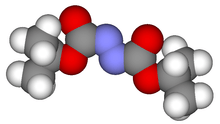Diisopropyl azodicarboxylate
Diisopropyl azodicarboxylate (DIAD) is the diisopropyl ester of azodicarboxylic acid. It is used as a reagent in the production of many organic compounds. It is often used in the Mitsunobu reaction[1] where it serves as an oxidizer of triphenylphosphine to triphenylphosphine oxide. It has also been used to generate aza-Baylis-Hillman adducts with acrylates.[2] It can also serve as a selective deprotectant of N-benzyl groups in the presence of other protecting groups.[3]
 | |
 | |
| Names | |
|---|---|
| IUPAC name
Diisopropyl azodicarboxylate | |
| Other names
DIAD | |
| Identifiers | |
3D model (JSmol) |
|
| ChemSpider | |
| ECHA InfoCard | 100.017.730 |
PubChem CID |
|
| UNII | |
CompTox Dashboard (EPA) |
|
| |
| |
| Properties | |
| C8H14N2O4 | |
| Molar mass | 202.210 g·mol−1 |
| Density | 1.027 g/cm3 |
| Melting point | 3 to 5 °C (37 to 41 °F; 276 to 278 K) |
| Boiling point | 75 °C (167 °F; 348 K) at 0.25 mmHg |
| insoluble | |
Refractive index (nD) |
1.418-1.422 |
| Hazards | |
| Safety data sheet | Sigma-Aldrich |
EU classification (DSD) (outdated) |
Flammable (F) Irritant (Xi) Env. Danger (N) |
| R-phrases (outdated) | R5, R11, R36, R37, R38, R43, R51, R53 |
| S-phrases (outdated) | S16, S26, S29, S36, S37, S39, S47, S61 |
| Flash point | 106 °C (223 °F; 379 K) |
Except where otherwise noted, data are given for materials in their standard state (at 25 °C [77 °F], 100 kPa). | |
| Infobox references | |
It is sometimes preferred to diethyl azodicarboxylate (DEAD) because it is more hindered, and thus less likely to form hydrazide byproducts.
One notable use of this compound is in the synthesis of Bifenazate (Floramite®).
References
- "Fluka DIAD on Sigma-Aldrich". Retrieved 2008-11-18.
- Shi, Min; Zhao, Gui-Ling (2004). "Aza-Baylis–Hillman reactions of diisopropyl azodicarboxylate or diethyl azodicarboxylate with acrylates and acrylonitrile". Tetrahedron. 60 (9): 2083–2089. doi:10.1016/j.tet.2003.12.059.
- Kroutil, J.; Trnka, T.; Cerny, M. (2004). "Improved procedure for the selective N-debenzylation of benzylamines by diisopropyl azodicarboxylate". Synthesis. 3 (3): 446–450. doi:10.1055/s-2004-815937.
This article is issued from Wikipedia. The text is licensed under Creative Commons - Attribution - Sharealike. Additional terms may apply for the media files.